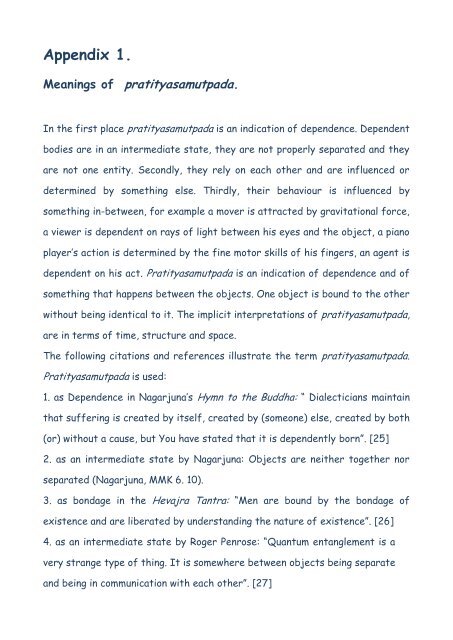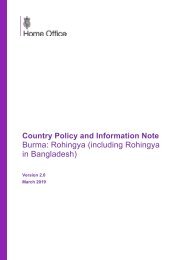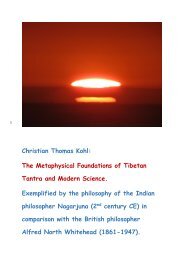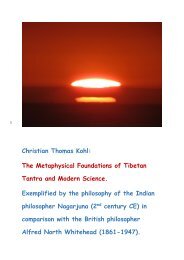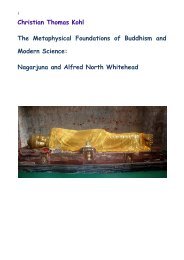The Metaphysical Foundation of Buddhism and Modern Science
The Metaphysical Foundations of Buddhism and Modern Science: Nagarjuna and Alfred North Whitehead
The Metaphysical Foundations of Buddhism and Modern Science: Nagarjuna and Alfred North Whitehead
Create successful ePaper yourself
Turn your PDF publications into a flip-book with our unique Google optimized e-Paper software.
Appendix 1.<br />
Meanings <strong>of</strong> pratityasamutpada.<br />
In the first place pratityasamutpada is an indication <strong>of</strong> dependence. Dependent<br />
bodies are in an intermediate state, they are not properly separated <strong>and</strong> they<br />
are not one entity. Secondly, they rely on each other <strong>and</strong> are influenced or<br />
determined by something else. Thirdly, their behaviour is influenced by<br />
something in-between, for example a mover is attracted by gravitational force,<br />
a viewer is dependent on rays <strong>of</strong> light between his eyes <strong>and</strong> the object, a piano<br />
player’s action is determined by the fine motor skills <strong>of</strong> his fingers, an agent is<br />
dependent on his act. Pratityasamutpada is an indication <strong>of</strong> dependence <strong>and</strong> <strong>of</strong><br />
something that happens between the objects. One object is bound to the other<br />
without being identical to it. <strong>The</strong> implicit interpretations <strong>of</strong> pratityasamutpada,<br />
are in terms <strong>of</strong> time, structure <strong>and</strong> space.<br />
<strong>The</strong> following citations <strong>and</strong> references illustrate the term pratityasamutpada.<br />
Pratityasamutpada is used:<br />
1. as Dependence in Nagarjuna’s Hymn to the Buddha: “ Dialecticians maintain<br />
that suffering is created by itself, created by (someone) else, created by both<br />
(or) without a cause, but You have stated that it is dependently born”. [25]<br />
2. as an intermediate state by Nagarjuna: Objects are neither together nor<br />
separated (Nagarjuna, MMK 6. 10).<br />
3. as bondage in the Hevajra Tantra: “Men are bound by the bondage <strong>of</strong><br />
existence <strong>and</strong> are liberated by underst<strong>and</strong>ing the nature <strong>of</strong> existence”. [26]<br />
4. as an intermediate state by Roger Penrose: “Quantum entanglement is a<br />
very strange type <strong>of</strong> thing. It is somewhere between objects being separate<br />
<strong>and</strong> being in communication with each other”. [27]


